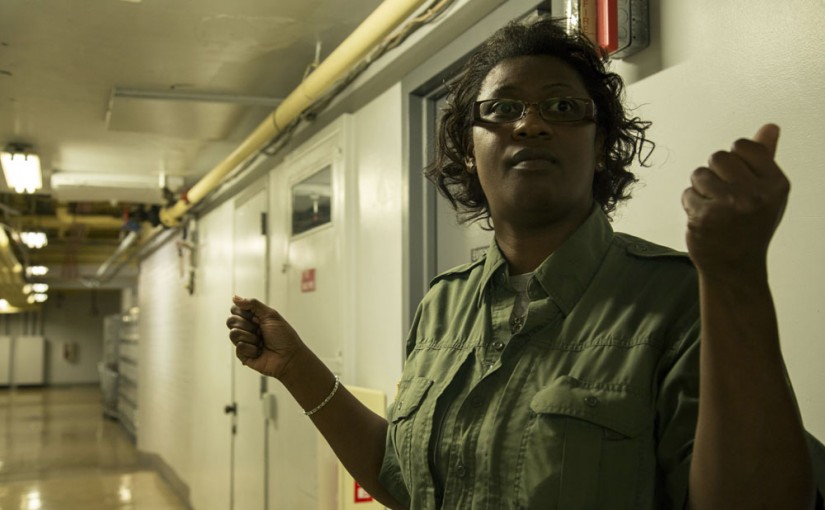
Because their work is sensitive, Charity Jackson and other technicians in the property and evidence unit had to pass a rigorous background check and a polygraph test.
BY CAITLIN ASHWORTH
NNB Student Reporter
ST. PETERSBURG – On the floors above Charity Jackson’s department at the St. Petersburg police station, all is commotion and bustle as sworn officers and civilian employees move through their day.
But on the windowless bottom floor, things seem more subdued as Jackson, 40, and other property and evidence technicians process and store the bodily fluids, drugs and ominous looking instruments of mayhem that are key to numerous cases, some going back five decades.
Five technicians and a supervisor, Melvin Brathwaite, work in the property and evidence section. To be hired, they must go through the same rigorous background check, including a polygraph test, as sworn officers.
“Just Be Nice,” reads a sign over the counter that Jackson stands behind.
She handles so-called “general evidence,” such as hats and watches, and has been a civilian employee at the Police Department for 12 years.
The evidence is housed in several rooms, and Jackson walks through them, describing each one.
When she unlocks Room 3, there is a faint whiff of marijuana. Instructions posted on the wall describe how to test and handle drugs. Blue lockers lining one wall contain drug-related evidence. A small refrigerator keeps urine and blood samples fresh.
Guns have a room of their own, from assault rifles to BB guns.
General evidence is stored in gray lockers down the hall while “bulk evidence,” such as lawn mowers, sits in a garage unit awaiting pickup by a private company that buys and sells booty that was seized by police and is no longer needed in the prosecution of crimes.
“I have one more room,” says Jackson. “The homicide room.”
That is Room 8. When she unlocks the door, chilly air seeps out. This room is kept much colder than other evidence rooms to help ensure that DNA left on the evidence is preserved, Jackson says.
A collection of murder weapons sits in an organized but jumbled fashion. Amid brooms and mops lined against a wall is a black samurai sword, an icon of Japanese history that is often dramatized in movies.
This sword is not mounted on the wall in prestige and glory, however. It is just another piece of evidence, with a case number written on the brown paper wrapping.
According to the department, St. Petersburg police closed 86 percent of the city’s 2014 homicides, ending the year with three cases unresolved and evidence waiting.
The department’s property and evidence staff processes and stores more than 22,000 new items and disposes of more than 17,000 items each year, according to the department’s website.
Items that have been cleared for release by the investigating officers sometimes go back to their owners. Some items are sold to the private company that then resells them. All firearms are destroyed.
On rare occasions, evidence is lost, said police spokesman Mike Puetz. “But it is extremely rare; there are a number of checks and balances that prevent that from happening.”
In June, the department created a full-time “cold case” team of five officers and civilian investigator Brenda Stevenson to focus on 213 unsolved murder and missing person cases going back as far as 1968.
A month earlier, the department finally identified a 16-year-old runaway from Virginia who died in 1973 after she was pushed in front of a vehicle in the 800 block of 11th Avenue S.
Stevenson persuaded the Pinellas-Pasco Medical Examiner’s Office in 2010 to exhume the unidentified teenager and two others from their unmarked graves to get DNA samples – a staple of modern investigations that did not become widely available until the 1990s.
The DNA helped the department determine the teen’s identify and notify her younger brother in North Carolina. The brother, who had searched for his sister for years, told reporters he planned to have her remains shipped to him so “she will finally be with me.”
Information from the Tampa Tribune and Tampa Bay Times was used in this report.

